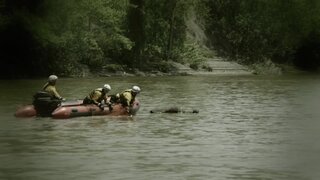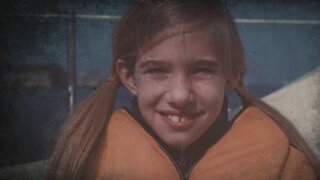Create a free profile to get unlimited access to exclusive videos, breaking news, sweepstakes, and more!
Potential ‘Smiley Face’ Victim Tommy Booth: Experts Dispute ‘Probable Drowning,’ Believe Body Could Have Been Dumped
“This is not a case that can honestly be ignored," said forensic pathologist Dr. Cyril Wecht.
When the body of 24-year-old Tommy Booth was discovered facedown in a Woodlyn, Pennsylvania creek two weeks after he went missing, the medical examiner noticed a suspicious set of footprints and marks at the death site.
Above Booth’s head and torso, there was a “drag mark” in the soil with “possible foot/shoe impressions” on either side of it, according to an autopsy report by the Delaware County Medical Examiner’s Office. The mark was directed upstream from the current, making it plausible that Booth’s body had been dragged by its feet through the creek by an unknown assailant.
Still, based on the available evidence, the medical examiner ruled his death a “probable drowning.”
Booth’s case has been closed since 2008, but a new team of investigators is working to have his death reclassified as a homicide. Former New York Police Department detectives Kevin Gannon, Michael Donovan, Anthony Duarte and professor of criminal justice Dr. Lee Gilbertson believe Booth could be a potential victim of the Smiley Face Killers, an alleged gang of unknown serial killers that murders college-aged men, dumps their bodies in local waterways and paints smiley face symbols near the death sites.
During “Smiley Face Killers: The Hunt for Justice,” airing Saturdays at 7/6c on Oxygen, Gannon and Dr. Gilbertson met with crime scene reconstruction specialist Scott Roder, who built a CGI model of Booth’s death site using data from the creek and the autopsy report.
Roder then presented his findings to the team and Ridley Township Police Department Captain Scott Willoughby, one of the original investigators on Booth’s case. Though Willoughby found no evidence of foul play during his inquiry, he became skeptical of the drowning after noticing smiley face graffiti at the back of a bar where Booth was last seen alive.
Roder noted that in addition to the supposed drag mark, Booth’s feet were in a position that suggested he was pulled through the sand and mud by his legs. Willoughby contended the “drag mark” could have been formed by the water flowing around Booth’s body, creating a type of sandbar.
Even considering that possibility, Roder believes there is additional forensic evidence that suggests Booth was not a drowning victim.
“If you’re in the water for 14 and a half days and you are in fact a drowning victim, I think the body would have a much different appearance,” said Roder. “You would see excessive bloating, skin slippage, which we don’t see here with Tommy.”
There was also fixed lividity on the posterior of Booth’s body, which suggests that “when he died, he was lying on his back ... for a substantial period of time.”
“There’s no way to be on your back on a hard surface if you’re floating in a creek,” explained Roder.
Local law enforcement maintain that the creek had frozen over in the days Booth was missing, potentially causing the lividity to last longer than normal. Roder says this is impossible: “The tissue in a frozen body is in the fatty tissues and so forth, where the lividity is in the muscles and the joints.”
In addition to the lividity, rigor mortis was also discovered in parts of Booth’s remains.
“Rigor mortis sets in eight to 10 hours after death, and it stays for approximately 10 hours or so before it subsides,” explained Roder.
If Booth had been deceased in the water for two weeks, his body would not have been experiencing postmortem rigidity, said Roder.
Following Roder’s presentation, Willoughby asked to have the findings reviewed by consulting forensic pathologist Dr. Cyril Wecht. Dr. Wecht characterized Booth’s death as “highly suspicious for foul play” and agreed the rigor mortis was one of the more complicating components of the case.
“There’s no way in the world that rigor mortis remains fixed for 14 and a half days. It’s not even a close call,” explained Dr. Wecht.
Dr. Wecht agreed that Booth’s death should be re-examined, concluding, “This is not a case that can honestly be ignored.”
Following Dr. Wecht’s consultation, Gannon presented the recommendation to Willoughby. He has contacted the Delaware County Medical Examiner’s Office to evaluate the team’s evidence, and the Booth family is currently awaiting a response.
To hear more about the mysterious drowning of Toomy Booth, watch “Smiley Face Killers: The Hunt for Justice” on Oxygen.
[Photo: Courtesy of Barbara MacKay Bush]


































